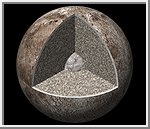|
COMETS EARTH JUPITER KUIPER BELT MARS MERCURY METEORITES NEPTUNE OORT CLOUD PLUTO SATURN SOLAR SYSTEM SPACE SUN URANUS VENUS ORDER PRINTS
PHOTO CATEGORIES SCIENCEVIEWS AMERICAN INDIAN AMPHIBIANS BIRDS BUGS FINE ART FOSSILS THE ISLANDS HISTORICAL PHOTOS MAMMALS OTHER PARKS PLANTS RELIGIOUS REPTILES SCIENCEVIEWS PRINTS
|
Related Document
Download Options
This image shows the 3 major divisions of the Lunar interior - the crust, mantle, and core. The thickness of the lunar crust varies from tens of kilometers in depth (under mare basins) to more than 100 kilometers in some highland regions, with an average thickness of about 70 kilometers. The core radius is between 300 and 425 kilometers. Man's limited knowledge of the Lunar interior comes primarily from seismic monitoring of lunar quakes, and from tracking spacecraft orbiting the moon. During Apollo missions 12, 14, 15, and 16, sensitive, seismic instruments were placed upon the lunar surface. These instruments detected mild moon quakes, some of which originated in the upper mantle and some deeper within. They also recorded occasional impacts (some natural and some man made) on the lunar surface. By monitoring how the quake/impact shock waves, of varying frequencies, propagate around and through the moon, scientists obtain a hint as to the nature of the lunar interior. Additional understanding of the lunar interior comes from Gravity Mapping. By tracking spacecraft as they orbit the moon, a picture of the structure and thickness of the crust is obtained. Dense material extruded into the crust changes the local gravity field, and as a spacecraft passes over these regions, slight velocity changes can be detected, yielding a picture of the crustal thickness. Based on information first gathered during the Apollo era, scientists suggested that the Moon was formed when a Mars-sized body hit the Earth during its early history. This impact occurred after the Earth's iron core had formed. Rocky, iron-poor material was ejected into orbit and then coalesced to form the moon. Recently, the Lunar Prospector spacecraft has confirmed that the Moon has a small core, supporting the Mars sized impact theory. The scientific evidence indicates that the lunar core contains less than four percent of the Moon's total mass, with the probable value being two percent or slightly less. This is very small when compared with the Earth, whose iron core contains approximately 30 percent of the planet's mass. Similarities in the mineral composition of the Earth and the Moon indicate that they share a common origin. However, if they had simply formed form the same cloud of rocks and dust, the Moon would have a core similar in proportion to the Earth's. This image is Copyright © 1999 by Calvin J. Hamilton. Any commercial/for-profit use of this image needs to be addressed to Calvin J. Hamilton. |
||||||||||||||||||||||||||||||||
